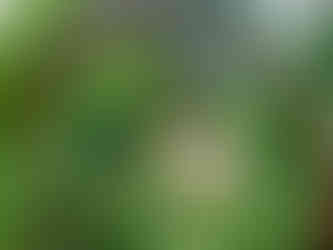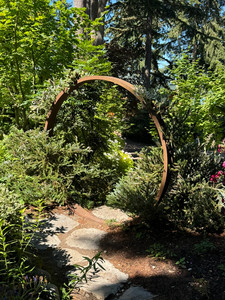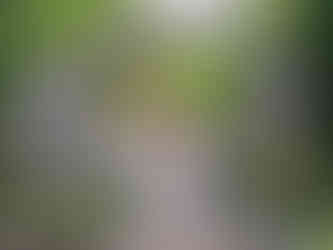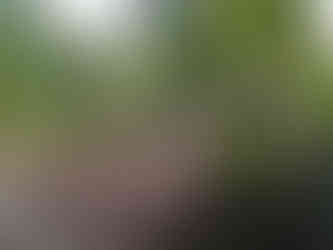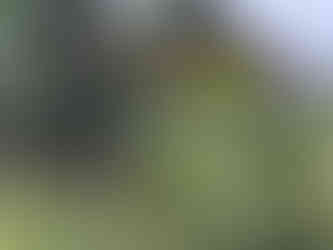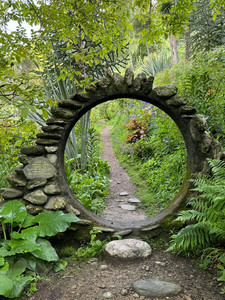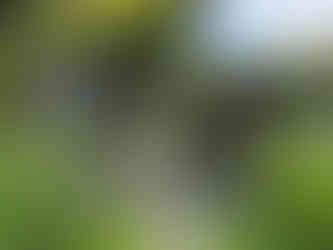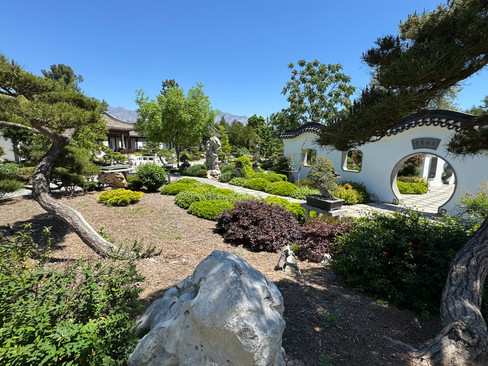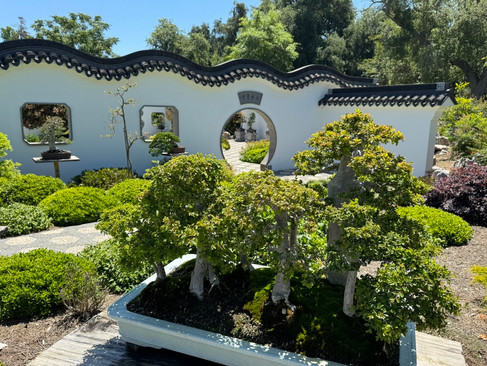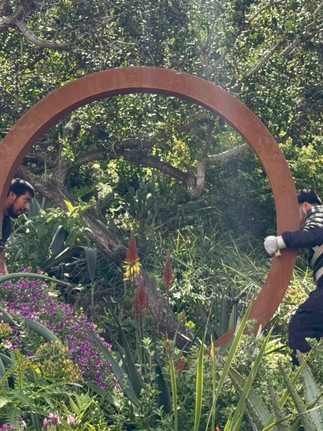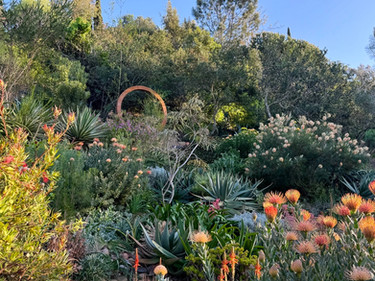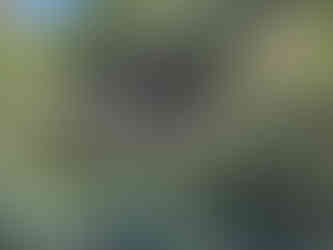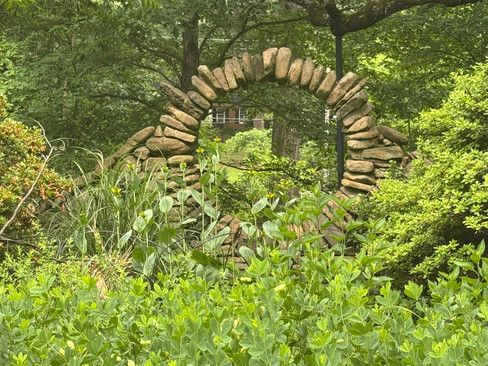MY LIFE WITH PLANTS: Over The Moon
- Jim Bishop
- Jun 30
- 8 min read
Text and photos by Jim Bishop, for Let's Talk Plants! July 2025.
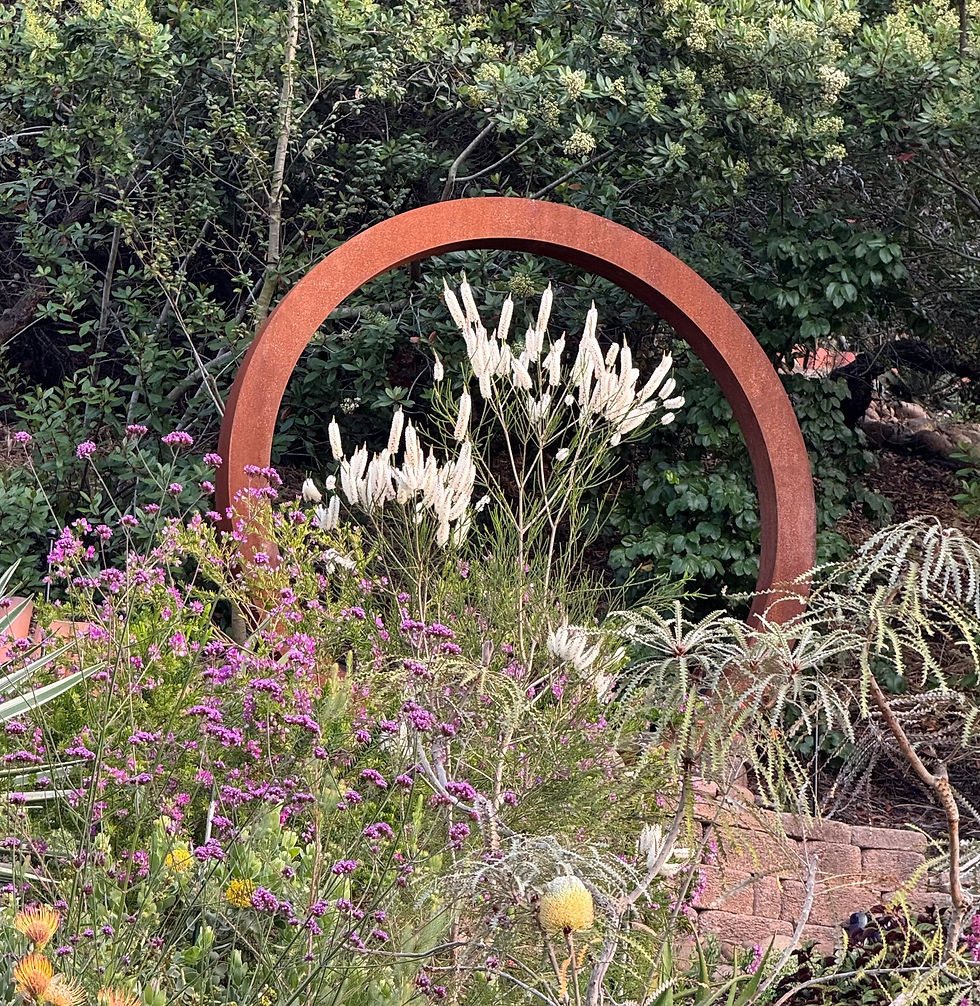
I don't remember when I first noticed moon gates in gardens. However, viewing old photos from garden tours, I discovered a few. The earliest photo was on a Pacific Horticulture Society tour of gardens in the New York area in 2011. We spent a day exploring gardens in New Jersey and visited an exceptional pair of neighboring private gardens. At the back of one of the gardens near the garage, there was an iron moon gate with a hanging pot.

In 2022, Scott and I were touring gardens primarily around Philadelphia, we dedicated the final day in New Jersey exploring several gardens featured in the Garden Conservancy Open Days. As we entered the back of the last garden before going to the airport, I began to recognize that we had visited it eleven years earlier.

Also while looking through old photos, I remembered seeing several moon gates in gardens during the Pacific Horticultural Tour in the Puget Sound area back in 2015. One moon gate was located in a private garden on Vashon Island, Washington. In their garden the Carharts had recreated the ambiance of the Cascade Mountains with a series of naturalistic pools cascading down the hillside linked by a stream and waterfalls. At the top of the garden stood a moon gate - seemingly made from a railroad rail bent into a circle.
Like the moon gate in New Jersey, I returned to the garden in 2024 during the annual Garden Blogger's Fling Tour. Nine years later, a section of the moon gate was adorned with a meticulously shaped blue fir.
The moon gate that I first paid close attention to was a few days later on the same 2015 Pacific Horticulture Society tour, in Redmond, Washington, garden. I don't fully recall the story behind it but believe it had recently been installed. I also don't recall how it was constructed, but it appeared to be mortarless (dry stack) and was using only gravity to hold it together.
Signs hanging from the arch read; "Please do not sit or lean on the moon gate!"
In front of the gate runs a rill.
It was a garden in the Mount Baker neighborhood, visited on the final day of the Garden Fling tour of Seattle gardens, that first inspired me to consider adding a moon gate to my own garden. The garden, created by Bonnie Berk and her partner, Larry Kessler, was filled with a stunning array of perennials and other treasured plants, and it showcased several corten (rusty steel) artworks. Towering above the street was a remarkable wide moon gate by Seattle metal artist Jim Honold of MOD Studio.

I thought this might work somewhere in my garden since I also garden on a very steep site.
Still intrigued by moon gates, I began searching for them during my visits to gardens. On a Hardy Plant Society of Oregon garden tour in New Zealand in November 2024, I encountered this innovative corten steel structure in Queensland.
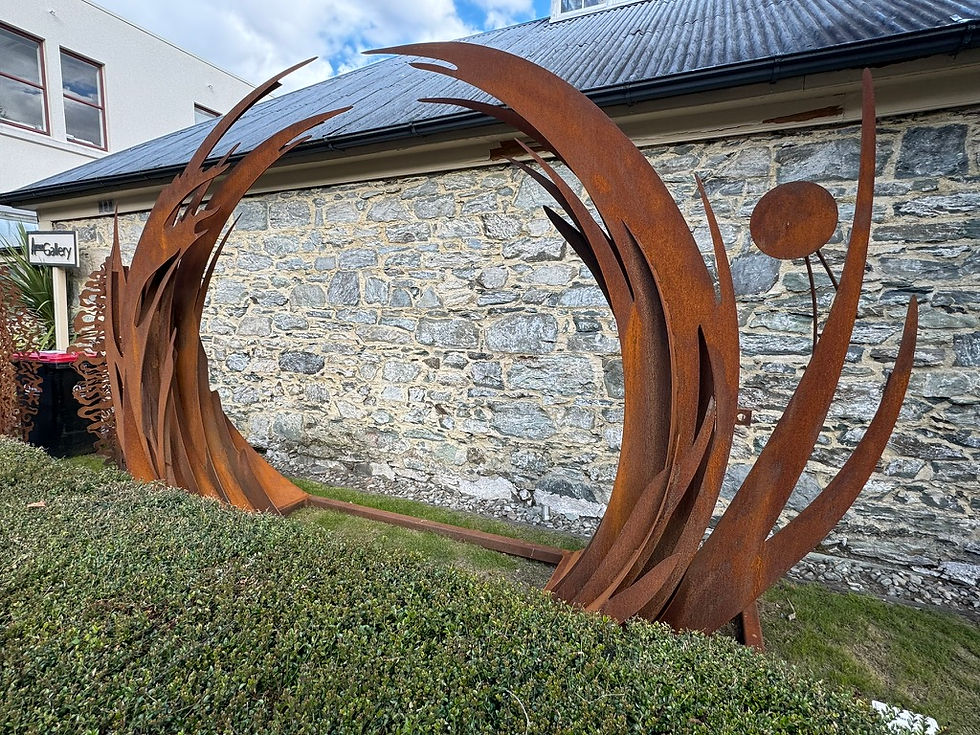
The moon gates that truly inspired me to consider one for my garden were two in the same garden on the last day of a garden tour in South Island, New Zealand. Both were located in the Wild Dream Garden, which spans the 45th south parallel. (You can learn more about the incredibly creative Wild Dream Garden online in the January Newsletter.) These were the imaginative creations of the garden owner, crafted entirely from local materials. At this point, I was captivated and knew my garden needed a moon gate.
A Bit of Moon Gate History
While researching the origins of moon gates, I couldn't find much information. However, it's possible they were initially inspired by natural arches such as these:
Top Row:
Scott Borden at Delicate Arch, Arches National Park, October 2013
Scott Borden at Skyline Arch, Arches National Park, October 2013
Second Row:
Anacapa Island, Channel Islands National Park, April 2023
Cabo San Lucas, Baja Sur, Mexico, May 2024
Chinese Gardens
However, the history of using moon gates in gardens dates back centuries to Chinese scholar's gardens, so it is unlikely that any of these natural arches where the original inspiration. Though walled off the world, scholar gardens were to be a microcosm of the world for contemplation and reflection.
The circular gates symbolized the full moon and served as passageways, typically through walls. This association with the full moon represented the passage of time or marked the beginning and end.
Here are a few from classical Chinese gardens I've visited:
The Huntington Chinese Garden has 3 moon gates
Entrance to the Huntington Chinese Garden.

Entrance to the Penjing (similar the Japanese Bonsai) display of dwarfed trees.
Sydney Australia, Chinese Friendship Garden
Lan Su Chinese Garden, Portland, Oregon
Moon Gate in Our Garden
Feeling inspired, I started considering the idea of adding a moon gate to the garden. Should it serve as a passageway? Should it frame a view? Should I construct it myself or buy a premade one?
After researching various online sources, I decided against building with rock and mortar. This process is very complex and beyond my skill level. I was also concerned about the weight, given the movement on our steep slope. Ultimately, I opted for a corten steel one from Terrain. However, despite reading and viewing photos online, I couldn't determine how it was anchored to the ground, though I learned it weighed 190 pounds. Terrain couldn't provide additional details about whether it was shipped in one piece or how to install it, which made me hesitant to purchase it. I knew it was imported and assumed it was from China. In January, there was talk of tariffs, so when I was offered a 10% discount, I decided to buy it. During my hesitation, the delivery date shifted from late January to mid-March and finally to late March. The price has since increased by $400, possibly due to tariffs.
In the meantime, I considered various locations for it in the garden. I ultimately decided against placing it where it would be possible to walk through, primarily because the garden paths are also used for maintenance access, which sometimes involves carrying large items that the moon gate would obstruct. Inspired by the positioning of moon arch I saw in Seattle, I eventually chose to position it high above the hillside planting, overlooking the lower garden. This placement would direct the view upward into the garden. Looking down from above, it would also partially block the view of the hotel parking garage and driveways and direct the focus down into the garden.
For years, I had considered adding new steps and pathways to a steep section of the garden that guests couldn't access. Over the months waiting for delivery, my garden assistant, Justin, and I worked on creating new paths, steps, seating areas, retaining walls, and adding boulders, irrigation, and lattice to conceal the nearby chain-link fence. The final step would involve incorporating rock, tile, and decomposed granite mosaics to the landings and paths.
Installation
When the gate was finally ready for delivery in late March, I still didn't know whether it would arrive in pieces or how to install it. Fortunately, the driver called me, and I discovered it was a large circle attached to a heavy metal plate with holes at the bottom for mounting. This required a change in delivery plans. Initially, I had planned for it to be delivered to the front of the house, assuming it would come in pieces. However, knowing it was an 8-foot, 190-pound arch, it was unlikely that Justin and I could carry it down about seven flights of steps into the garden.
I managed to convince the driver to deliver it through the gate at the bottom of the garden which opens to a hotel parking lot below our house. We have often used this gate to deliver heavy or large items to that part of the garden. I was hopeful that with the driver’s three helpers, plus Justin and me, we could at least get it partway up the hill. When they finally arrived, I persuaded them to carry it up the steps to where it would be installed.
Once in place, Justin and I used a power drill and bolts to secure it to the top of the retaining wall.
Final Placement
Finishing Touches - Bellissimo Bells
After the moon gate was installed, I noticed that from the landing where the gate was placed, it not only framed the lower garden but also provided an unobstructed view of the hotel parking garage behind our property. This was not acceptable. After extensive online shopping, I considered using wind chimes to add sound to the garden and mask the urban background noise. However, wind chimes are long and narrow, which wouldn't effectively hide much of the back view and would also obscure part of the garden view. Eventually, I discovered some wonderful custom-made, rusted metal triangular bells from California that were ideal. I ordered three—one large and two slightly smaller ones. The large bell features a metal sun to catch the wind, while the smaller ones have an oak leaf. They produce more of a clanging or gong-like sound than typical wind chimes.

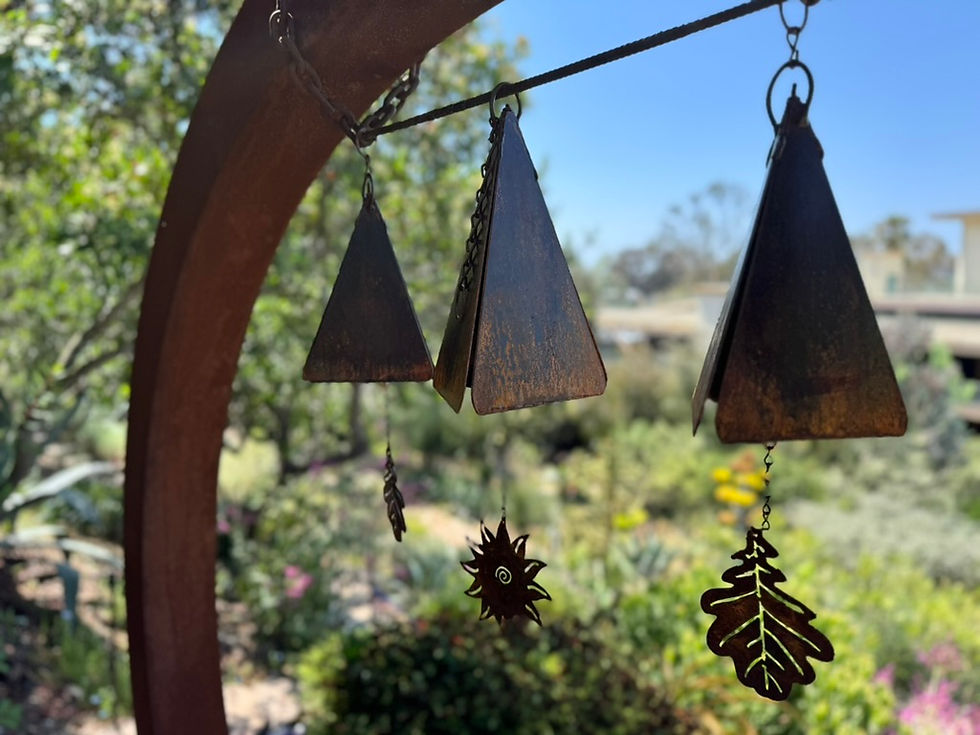

The bells are positioned at eye level, drawing attention to the bells, gate, and garden. Initially, I intended to mount them with three eyelet screws set into the gate. However, corten steel proved to be more durable than anticipated, and my drill couldn't even make a mark on it. As a result, I improvised using a rusty chain and rebar that I already had. I may replace the rebar with a thicker piece, but for now, this solution works.


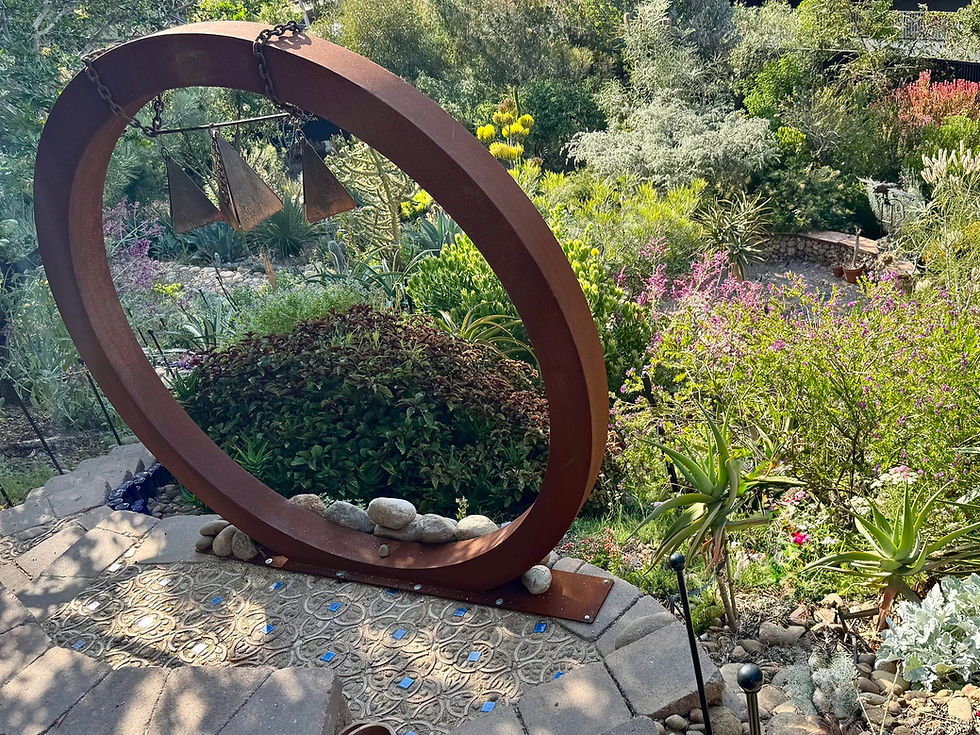
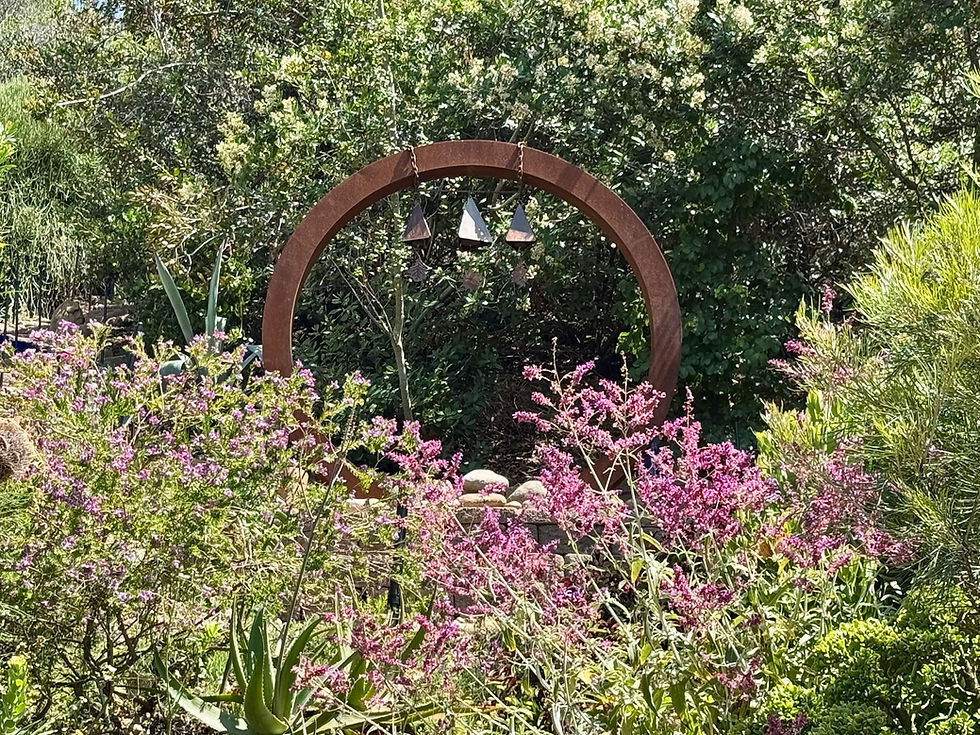
Many Moons
I now notice moon gates and other round or moon related items everywhere I visit. Here's a few:
Recalling school lunches of my childhood, Moon Pies were served in several of the Memphis 2025 Garden Fling. Turns out they were originally created in Tennessee.
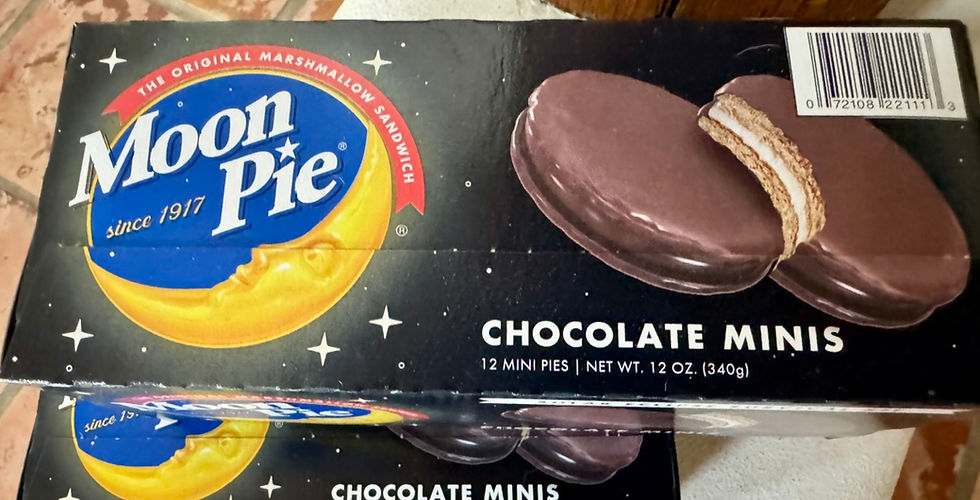
Very cool view of Tower Bridge under a willow sculpture called The Nest, by Spencer Jenkins. Photo by Janet Davis.

First Nations artist new installation on Cap Diamant in Quebec City in Joan of Arc Park overlooking the St. Lawrence Seaway.
Ludovic Boney’s sculpture Remembering Through Beads (Des perles en mémoire) is made up of a series of rings representing wampum beads. Traditionally made from seashells, these tubular purple and white beads can be strung together to form belts or woven necklaces. These items were ritually exchanged to seal diplomatic alliances between nations or to inscribe them in memory. Visited on a May 2025 driving tour of Quebec City area.

The Ring sculpture in Montreal was erected in 2023. Located in the central business district, it frames the view of McGill University and Mount Royal. Visited on a walking tour of Montreal, June 2025.

The Dr. Arsen Manugain Memphis estate signature moon gate. Visited June 2025 on the Garden Fling tour of East Memphis gardens.


